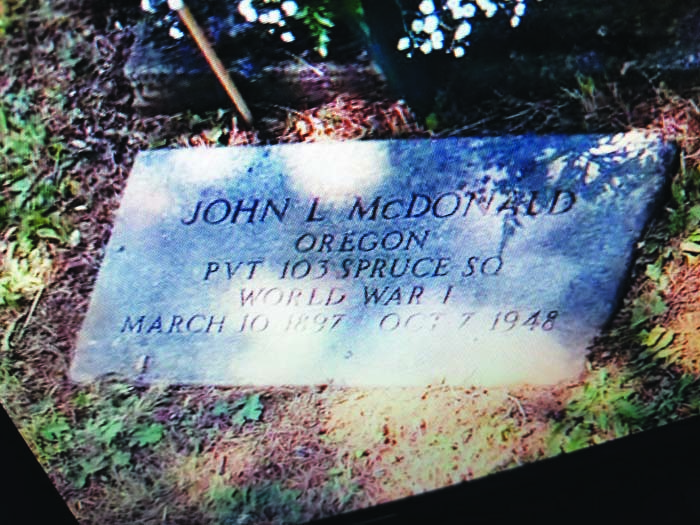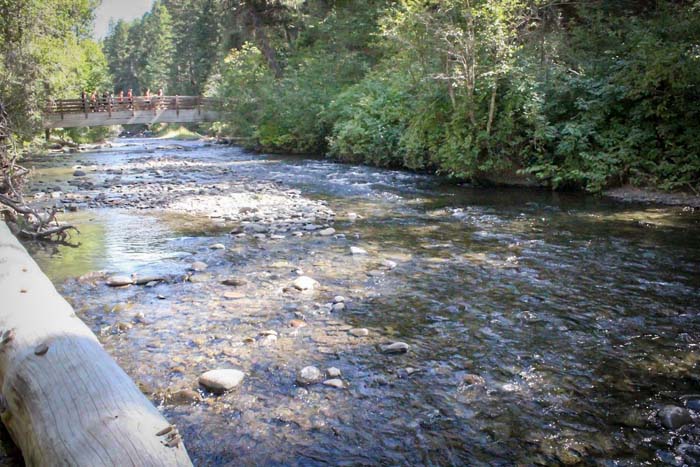The stirring story of the Spruce Squadron
Published 2:21 pm Tuesday, September 6, 2022

- The gravestone for John. L. McDonald, who served in the Spruce Squadron during World War I.
I never met my grandfather. He died from injuries sustained while working in the woods we now know as the Tillamook State Forest. He was a hard-working man, one with strength of character, and one who loved his family. He never intended to stay in Oregon but had hoped to return to his home of Boulder, Colorado, after the war. His family headstone now rests with other relatives. But his military headstone lies in the same cemetery, in a seldom visited area. It simply reads: “John L McDonald, Oregon, PVT 103 Spruce Sq, World War I, March 10 1897, Oct 7 1948.”
Trending
As World War I raged in the European theater, a striking problem arose for the Allies. There weren’t enough spruce trees to meet the demand for the growing number of aircraft that needed to be rapidly built. The solution? The Pacific Northwest in the United States. Oregon and Washington forests were ripe with the kind of timber that was desperately needed to continue the aerial assault on the Germans. And so, the Spruce Squadron was born.
The Allied nations were attempting to produce enough aircraft to keep the skies occupied over the front lines in France. The lumber industry in the United States had been supplying the Allies with spruce timber, especially important to the construction of wing spars and other aircraft parts. But as 1917 led into 1918, the logging industry was losing men to the draft. These labor shortages caused the flow of aircraft spruce to nearly disappear.
It was then that the Army formed the Spruce Production Division (SPD) with the goal of increasing the flow of airplane wood; the Army would provide men to work in the forests and mills. The production of timber for aircraft and ship building increased as spruce, fir and cedar were logged.
Trending
These Army men worked with the civilians in the forests and mills and received the same wages (minus their military pay). They additionally built and worked in a special wood production plant at Vancouver. They were able to supply the type of wood needed for the airplane manufacturers, as most mills in the US were not setup for that type of production.
Roads and railroads were built wherever they were needed to reach the spruce stands along the Pacific coast.The SPD men learned to operate the railroads, they learned to drive log trucks, and they learned how to cut the timber so desperately needed in Europe.
The Army enforced minimum requirements for work hours, lodging and food. The government contractors hired to oversee the work were regularly inspected by Army staff. There were labor issues and those who spoke out against the government were removed from the lumber work force. Many soldiers built their own barracks, others lived in tent cities.
A great number of the soldier workforce wanted to go “over there” and take part in the fighting, but their labor was needed in Oregon and Washington.
By November 1918, approximately 28,000 soldiers were working with about 100,000 civilians. Of these, about 18,000 soldiers were engaged in logging, construction, and mill work. Another 4,000 worked at the lumber mill in Vancouver. And 4,000 more soldiers were permanently assigned to the Vancouver Barracks, their job was to help with supply, HQ operations, etc., and as an armed force designed to maintain peace in the volatile labor environment of the logging industry. Some were also sent to fight forest fires.
The Spruce soldiers experienced isolation problems as many of the small camps were far from towns with little to no communication from the outside world. Smaller camps were frequently moved as logging and construction was completed or new projects areas were started. Many were not able to receive mail from home as they had no address. The soldiers at the Vancouver Barracks were more fortunate as they had a physical address to receive mail. And many chose to stay after the war effort had ended.
My grandfather never went back to Colorado. Instead, he chose to stay in the area he now called home. There were still many good jobs in the forests he grew to know so well. He settled in Tillamook and continued to work in the woods, as he’d become a supervisor of a timber crew and was known as an excellent and fair boss.
He broke a lot of hearts that day in October 1948. My father stayed in Tillamook and raised his family there, too. And now you know the rest of my story.
Want to learn more?
Most of the information regarding the Spruce Squadron is taken from “The U.S. Army Spruce Squadrons in the First World War,” written by Bob Swanson. Bob has devoted years to compiling information and research about the Spruce Squadron, and his website, www.swansongrp.com has a tremendous amount of information regarding the SPD.
Typing “spruce squadron” into your internet browser will bring up enough links to keep even the most devoted historical buffs busy for a long, long time. There you will find internet links to many sites that have rosters of the Squadrons, maps of Army built railroads, dozens of photos taken during this time, and photos of the interiors of the mills. It’s fascinating history.









